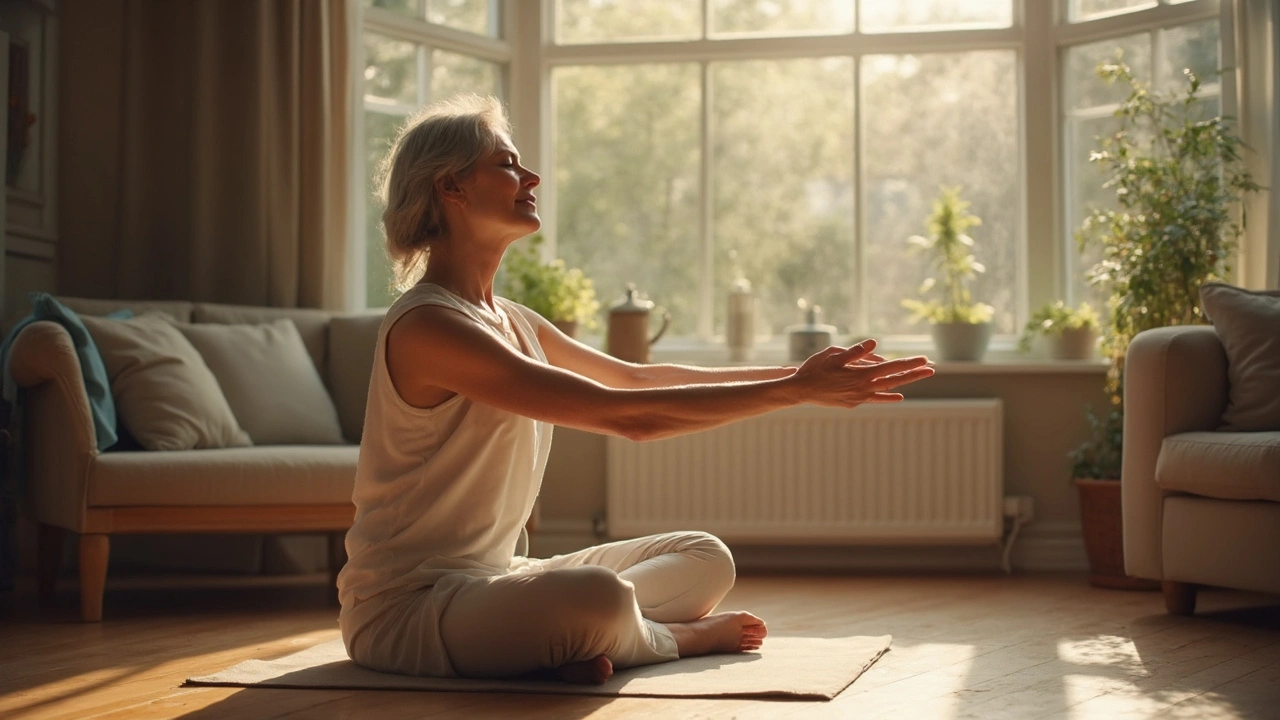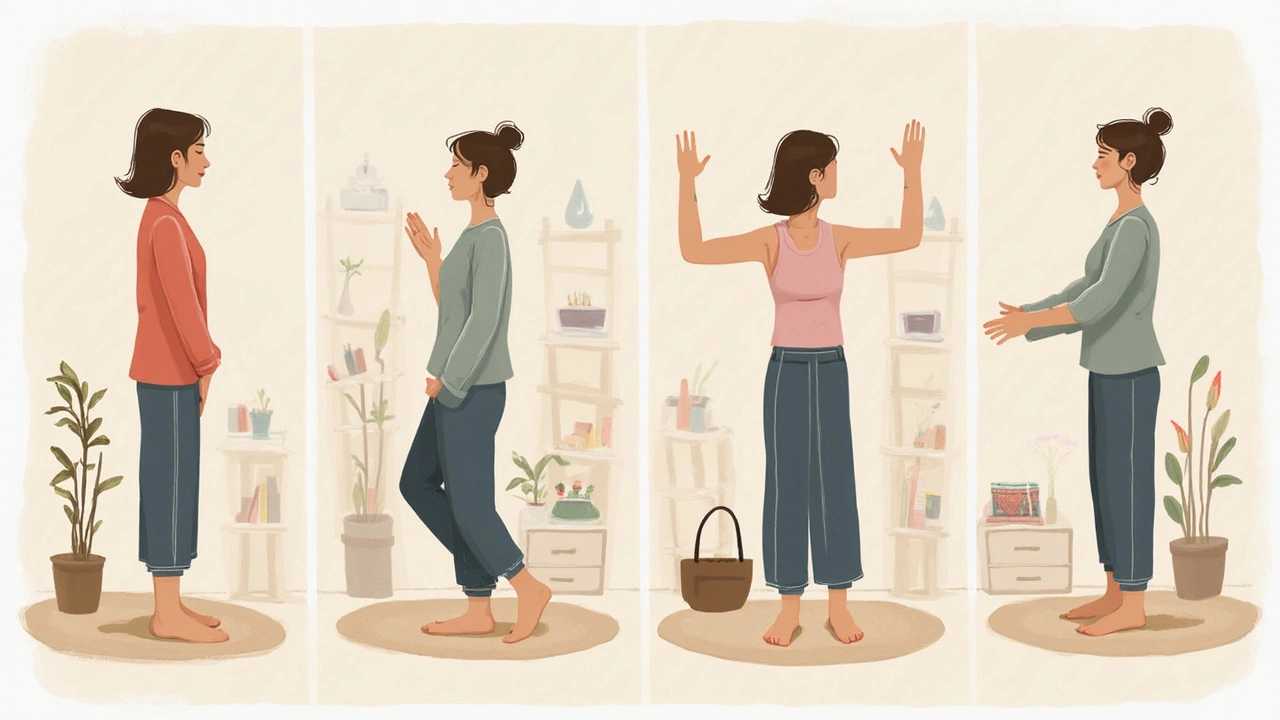Breema: Mind-Body Wellness Techniques and Benefits Explained
 Aug, 17 2025
Aug, 17 2025
Stressed, disconnected, or just tired of the same old wellness routines? Breema throws out the rulebook, blending movement, gentle touch, and mindfulness in a way that doesn't look or feel like anything else in the body-mind scene. It doesn’t ask you to stretch into a pretzel or sit still for hours. Instead, it offers actual tools to help you relax, feel centered, and deal with everyday chaos without zoning out or losing touch with reality.
- Breema combines movement, touch, and presence to unify body and mind.
- It's accessible—no need to be flexible or fit. Anyone can try Breema, at any age.
- The practice stands out because of its Nine Principles of Harmony, like Comfort and No Force.
- Scientific research supports benefits: less stress, better focus, and a stronger sense of self.
- You can start Breema at home or with a certified practitioner.
What Is Breema? Quick Breakdown
Picture this: You're lying comfortably, and someone gently rocks, stretches, and leans into your body in sync with your breath. That's Breema—a hands-on, partner-based or solo practice built around simple, rhythmic movements. But it isn't a massage, though it borrows a few tools from bodywork. It isn't yoga, either—there's no aiming for a particular shape. The heart of Breema is presence. Every move is meant to connect you—here and now—to your body, your breath, and your reality.
The method comes from ancient Persian and Central Asian traditions, but it took shape in the U.S. in the late 1970s, led by Dr. Jon Schreiber, director of The Breema Center in California. It’s based on the Nine Principles of Harmony: things like “No Judgment,” “Body Comfortable,” and “Single Moment/Single Activity.” The sessions, whether partner or solo, flow through gentle stretches, leaning techniques, and mindful touch, helping you actually feel back in your own skin.
Unlike some wellness trends, Breema doesn’t ask you to check out from life—it’s about tuning into it. No huge time commitment, no sweat, and you don’t need gear or a teacher to get started. All you need is the willingness to try.
How Breema Works: The Core Principles In Action
The real magic happens in how Breema is done, not just what gets done. Here’s how it actually plays out in practice:
- Body Comfortable: No pushing your limits. If a position doesn’t feel right, you adapt it.
- No Force: Movements and touch are gentle—never aggressive. This isn’t about "fixing" you.
- Mutual Support: Whether giving or getting, everyone benefits. The person practicing and the recipient both feel the effects.
- No Judgment: Breema leaves competition and criticism at the door. No comparing yourself or others.
- Firmly Rooted in the Present: Every move brings your attention to what your body feels—now.
During a typical Breema session, you’ll be guided through gentle stretches, rhythmic rocking, and leaning touch. Every technique aims to bring your attention away from constant mind chatter to what’s actually happening in your body. Techniques are done fully clothed, on a padded floor or mat. For solo “Self-Breema” routines, you learn short sequences of movement you can do at home, in the office, or even while waiting for a bus.
Breema doesn’t try to diagnose or fix symptoms. Instead, as your mind and body sync up, people often notice old aches ease, stress drops, and their mood lifts. What’s unique? The process is the goal—you get benefits just from paying attention and being present.
Main Benefits: Research and Real-World Results
People chasing "the next big thing" in wellness have standards: Is this safe? Is there proof? Can I do it easily? Breema checks all the boxes.
- Lower stress. Peer-reviewed studies published by the Journal of Integrative and Complementary Medicine in 2024 (Carter & Lee) tracked stress hormone levels in adults doing Breema for six weeks—cortisol dropped by 28% on average.
- Improved focus. In a University of Munich pilot (2023), participants reported better sustained attention and mental clarity after two months of weekly sessions.
- Better mood, less anxiety. A clinical trial from San Francisco State in 2022 found Breema group participants cut their anxiety scores in half—most after just four sessions.
- Pain relief. In a practical sense, folks with chronic tension and pain rated their pain as 30%-40% less severe after regular sessions, according to ongoing data collected at The Breema Center.
Real stories bring those numbers to life: Maggie started practicing Breema following a back injury and said it let her "reclaim" her body without fear of re-injury. Jamal, a chef on his feet all day, uses short Self-Breema sequences when stress peaks: "My mind stops spinning and my body relaxes, even with work chaos still happening," he says.
| Benefit | Study/Source | Result |
|---|---|---|
| Lower Stress | J Integrative Comp Med (2024) | ↓28% cortisol levels |
| Improved Focus | Univ Munich (2023) | ↑Attention span in 75% of participants |
| Reduced Anxiety | SFSU Trial (2022) | ½ anxiety scores after 4 sessions |
| Pain Relief | Breema Center Data | ↓30–40% reported pain |

Trying Breema: Step-by-Step Basics
Keen to try? Here’s what actually happens:
- Step 1: Find a session. Search "Breema practitioner near me" or check online for certified group classes. The Breema Center offers intro workshops, some by video chat.
- Step 2: Dress comfortably. No shoes, no need for fancy gear. Show up as you are.
- Step 3: Observe. Your practitioner will invite you to notice your body, breath, and movements as you go through simple stretches and holds.
- Step 4: Try Self-Breema. At home, try a basic sequence: stand with feet shoulder-width, rock gently from side to side, synchronize breath with movement, and simply observe physical sensations. Two minutes is enough to notice a difference.
- Step 5: Repeat. Regularity matters more than duration—even a short daily Self-Breema session can improve your sense of balance and calm.
Pro tip: The goal is never to “achieve” a pose or result. Breema is about the process, not performance. If you’re thinking too hard, return attention to feeling your breath, hands, or feet. If you’re working with a practitioner, it’s okay to speak up if you’re uncomfortable with any movement.
Compare Breema With Other Mind-Body Practices
With so many options promising calm and body awareness, why Breema? Here’s how it stacks up against similar techniques:
| Practice | Main Focus | What’s Involved | Who’s It For? | Needs Equipment/Space? |
|---|---|---|---|---|
| Breema | Presence, harmony | Gentle movement, touch, mindful awareness | Any age/fitness | No |
| Massage | Muscle tension relief | Passive touch, specific techniques | Varies | Table/oils |
| Yoga | Flexibility, breath | Poses, breathing, sometimes philosophy | Flexible or looking for exercise | Mat, space |
| Tai Chi | Balanced movement/energy | Slow, flowing movements | Best for mobile adults | Space |
| Meditation | Mental focus | Sitting or lying, guided or solo | Self-motivated | Quiet spot |
If you want a practice that welcomes you as you are, doesn’t need a big time chunk or athletic skills, and instantly feels different, Breema actually stands out. Particularly for those who have found yoga or meditation too intimidating, static, or disconnected from the physical, Breema brings body and mind literally back together.
Mini-FAQ: Biggest Questions About Breema
- Is Breema safe? Yes. Because there’s no forced stretching or painful techniques, Breema is considered safe for most, including elderly or those dealing with injury. Always check with your health provider if unsure.
- Do I need a partner? No. While full sessions usually involve a practitioner, there’s a full set of solo Self-Breema exercises you can do anywhere.
- How quickly do I see results? Most report some shift—relaxation, less tension—after only 1-2 sessions, especially with regular practice.
- How do I learn Breema? Look for certified practitioners or classes via breema.com, or check for wellness centers listing Breema bodywork in your city.
- What if I have special needs or injuries? Movements are always adapted. Let your practitioner know, and focus on comfort and gentle movement.

Next Steps: Getting Started With Breema
If you’re curious but want zero commitment, try a Self-Breema video—it takes less than five minutes and needs no equipment. Notice if you feel any change in your body or mind. Know someone also stressed out? Invite them to try a partner stretch or movement.
If you want depth or help for a chronic issue (think tension, anxiety, pain), book a full session with a certified Breema practitioner—search local wellness directories or ask at your community center. If you’re already seeing a bodyworker or therapist, ask if they know of someone trained in Breema to get a referral.
And here’s a tip for skeptics: don’t overthink it. If you’re always looking for something new that actually sticks, Breema may be the low-effort, high-reward shift you didn’t know you needed. Try it, pay attention to how you feel, and decide if it belongs in your toolbox for real mind-body change.
